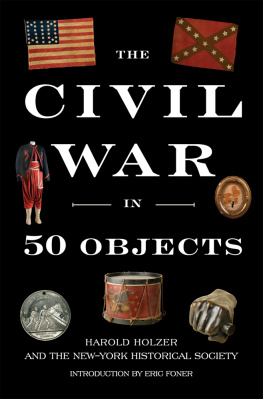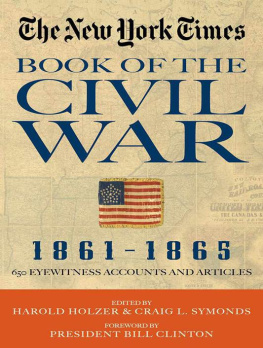
VIKING
Published by the Penguin Group
Penguin Group (USA) Inc., 375 Hudson Street, New York, New York 10014, USA

USA | Canada | UK | Ireland | Australia | New Zealand | India | South Africa | China
Penguin Books Ltd, Registered Offices: 80 Strand, London WC2R 0RL, England
For more information about the Penguin Group visit penguin.com
Copyright New-York Historical Society, 2013
All rights reserved. No part of this book may be reproduced, scanned, or distributed in any printed or electronic form without permission. Please do not participate in or encourage piracy of copyrighted materials in violation of the authors rights. Purchase only authorized editions.
Illustration credits
Plate no. 501: Courtesy of David Rubenstein
Other illustrations from the collection of the New-York Historical Society
LIBRARY OF CONGRESS CATALOGING-IN-PUBLICATION DATA
Holzer, Harold.
The Civil War in 50 objects / Harold Holzer and the New-York Historical Society; with an introduction by Eric Foner.
pages cm
Includes bibliographical references and index.
ISBN: 978-1-101-62838-6
1. United StatesHistoryCivil War, 18611865Antiquities. 2. United StatesHistoryCivil War, 18611865Museums. 3. United StatesHistoryCivil War, 18611865Anecdotes. 4. United StatesHistoryCivil War, 18611865Collectibles. 5. New-York Historical Society. I. Foner, Eric. II. New-York Historical Society. III. Title.
E646.H65 2013
973.7075dc23
2013001532

 TO
TO
RICHARD GILDER
Chairman Emeritus of the New-York Historical Society
and
ROGER HERTOG
Chairman of the New-York Historical Society

For the inspiration to find usable lessons from the past
[W]e cannot escape history.
Wewill be remembered in spite of ourselves.
Abraham Lincoln
Annual Message to Congress, December 1, 1862


O N A WINTRY EVENING IN 1804, THE NEW-YORK HISTORICAL SOCIETY was founded by eleven visionary men as a permanent means of preserving the historical record of Americas past. All of the founders had lived through a time when the streets of New York City were riotous with rebellion and economic uncertainty, when much of the city was burned in the wake of British occupation during the Revolutionary War. They had also lived through the birth of the new nation and George Washingtons inauguration as first president of the United States, in New York, the nations first capital. With a keen sense of the importance of their own historical moment and a strong consciousness of the challenges ahead, they laid the groundwork for a vast collection of documents, books, art, and artifacts that would be a guide and inspiration for generations to come. Early on these men declared that the Societys vision was not to be limited to a single State, or district, but extend to the whole Continent. Thus the New-York Historical Society became the first institution in America to collect the history of the nation.
Fifty-nine years later, as civil strife burst upon the streets of New York City again, with draft riots and bloodshed over threats to the union of the American states, the New-York Historical Society had become one of the greatest American history libraries in the country and the only important museum in New York. It was foreseeable that a great proportion of the wealth of objects collected in relation to the Civil War would soon find its way onto the Societys bookshelves and into its galleries and halls. Presaging a Civil War collection that would eventually tell the history of the period uniquely, gifts began arriving almost immediately after the end of the war: the Civil War library of General John Watts de Peyster; the collection of Daniel Parish Jr., comprising more than twenty-one thousand slavery pamphlets, over sixty-five hundred manuscripts, and twelve hundred photographs dealing with the Civil War; two Civil War swords; the Meserve collection of actual Civil War photographs, including Lincoln, mounted in twenty-eight folio volumes (one of four sets made); the personal papers of General Franz Sigel, the popular Civil War hero of the German citizens of New York, numbering over a thousand pieces; and Thomas Nasts preliminary oil sketch for Departure of the Seventh Regiment for the War. The Societys collections around the Civil War continued to grow over the next century, reaching an unparalleled breadth and depth when, as part of its bicentennial celebrations in 2004, the Gilder Lehrman Collection, a unique archive of primary sources in American history, was placed on deposit at the Society and made available to researchers. Among the Gilder Lehrman Collections great Civil War treasures are general orders; orderly books; recruitment broadsides; maps, photographs, and newspapers; and the journals, official dispatches, and personal letters of military commanders, politicians, soldiers, and civilians. The archive includes letters and diaries written by statesmen, soldiers, and civilians that provide extraordinary perspectives on virtually every aspect of the Civil War, including battles, life on the home front, Lees surrender, Lincolns assassination, and prisoner-of-war experiences. Thousands of soldiers letters and diaries, most of them unpublished, capture the experience of the common soldier and his family in great detail.
For many years now, the history of the Civil War has come to life for scholars, students, and the historically minded general public through objects in the New-York Historical Society. But today, as the sesquicentennial of the war is commemorated, the collection occupies an even greater place of privilege. It is our good fortune to be able to share fifty of our million or so Civil War objects with readers of this book. Even the most avid Civil War buffs among you will discover much that will appear new! We are fortunate to have as author and guide the great Lincoln scholar Harold Holzer. Eric Foner, the renowned historian of the Civil War and Reconstruction, has written an introduction of great substance that, as always with the best historians, is provocative of thought. I am grateful to my colleague the New-York Historical Societys historian and vice president, Valerie Paley, for her work as part of the team. My colleagues Jean Ashton and Linda Ferber and their library and museum staffs were instrumental in suggesting objects from which the fifty presented in this book were drawn. It was Wendy Wolfs idea to do this book, and I thank her and her Viking colleagues for recognizing our collection and staff as uniquely suitable for the task. I am also pleased to acknowledge the generosity of David Rubenstein for his special loan of the Thirteenth Amendment.











 TO
TO
